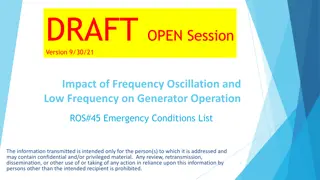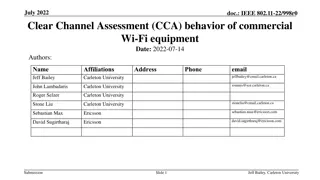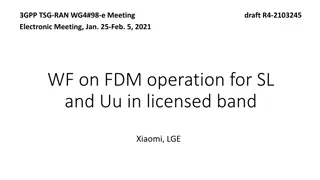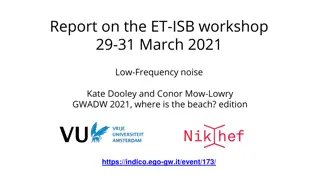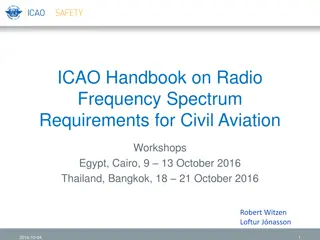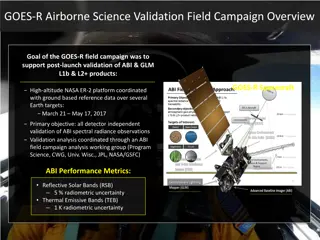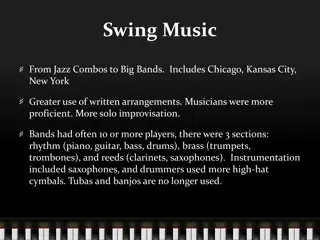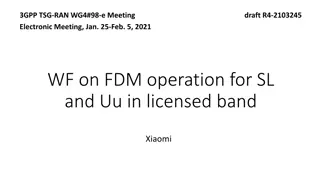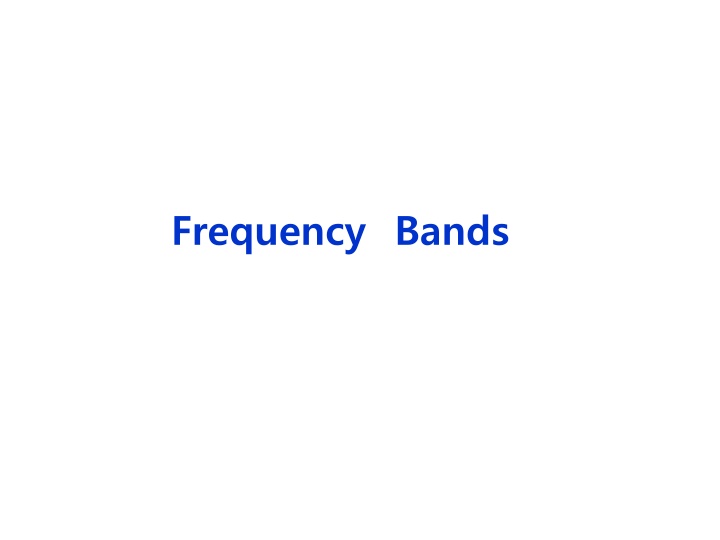
Explore Frequency Bands and ITU Regions in Telecommunication
Discover the various frequency bands used in telecommunications, including ITU bands, ECM bands, EU/NATO radio bands, IEEE radio bands, and Waveguide frequency bands. Dive into the ITU regions and learn about the International Telecommunication Union and its spectrum regions.
Download Presentation

Please find below an Image/Link to download the presentation.
The content on the website is provided AS IS for your information and personal use only. It may not be sold, licensed, or shared on other websites without obtaining consent from the author. If you encounter any issues during the download, it is possible that the publisher has removed the file from their server.
You are allowed to download the files provided on this website for personal or commercial use, subject to the condition that they are used lawfully. All files are the property of their respective owners.
The content on the website is provided AS IS for your information and personal use only. It may not be sold, licensed, or shared on other websites without obtaining consent from the author.
E N D
Presentation Transcript
I. Frequency Bands 1. ITU bands 2. ECM bands 3. EU/NATO radio bands alternative 4. IEEE radio bands 5. Waveguide frequency bands
1. ITU (International Radio Union) bands 1 (ELF) 3-30 Hz 2 (SLF) 30-300 Hz 3 (ULF) 0.3-3 kHz 4 (VLF) 3-30 kHz 6 (LF) 30-300 kHz 7 (MF) 0.3-3 MHz 8 (HF) 3-30 MHz 9 (VHF) 30-300 MHz 10 (UHF) 0.3-3 GHz 11 (SHF) 3-30 GHz 12 (EHF) 30-300 GHz 13 (THF) 0.3-3 THz
2. ECM bands (EU/NATO/US) A 0 250 MHz B 250-500 MHz C 0.5-1 GHz D 1-2 GHz E 2-3 GHz F 3-4 GHz G 4-6 GHz H 6-8 GHz I 9-10 GHz J 10-20 GHz K 20-40 GHz L 40-60 GHz M 60-100 GHz
3. EU/NATO radio bands alternative I 100-150 MHz G 150-225 MHz P 225-400 MHz L 0.39-1.55 GHz S 1.55-3.90 GHz C 3.9-6.2 GHz X 6.2-10.9 GHz K 10.9-36.0 GHz Ku 10.9-20 GHz Ka 20-36 GHz Q 36-46 GHz V 46-56 GHz W 56-100 GHz
4. IEEE radio bands HF 3-30 MHz VHF 30-300 MHz UHF 0.3-3 GHz L 1-2 GHz S 2-4 GHz C 4-8 GHz X 8-12 GHz Ku 12-18 GHz K 18-27 GHz Ka 27-40 GHz V 40-75 GHz W 75-110 GHz mm 30-300 GHz
5. Waveguide frequency bands R 1.70-2.60 GHz D 2.20-3.30 GHz S 2.60-3.95 GHz E 3.30-4.90 GHz G 3.95-5.85 GHz F 4.90-7.05 GHz C 5.85-8.20 GHz H 7.05-10.10 GHz X 8.2-12.4 GHz Ku 12.4-18.0 GHz K 15.0-26.5 GHz Ka 26.5-40.0 GHz Q 33-50 GHz U 40-60 GHz V 40-75 GHz W 75-110 GHz F 90-140 GHz D 110-170 GHz G 140-220 GHz Y 325-500 GHz = 2 a b c = = 2 , a f c c c 1.25 1.9 f f f c c
II. ITU Regions 1. ITU 2. ITU radio spectrum regions
1. ITU (International Telecommunication Union) - - . - ITU-R ( ): 1927 - ITU-T ( ): 1956 - ITU-D ( ): 1992 - ITU Telecom ( ): 1971 . ITU Telecom World 2011 (40 ) - WRC ( , ): World Radiocommunication Conferences 3-4 . , / , ,
III. Frequency per Applications 1. Broadcast frequencies 2. GNSS frequencies 3. Aeronautical telemetry frequencies (WRC'07)
1. Broadcast frequencies Longwave AM Radio Medium Wave AM Radio Shortwave AM Radio FM Radio 148.5-283.5 kHz 530-1710 kHz 3-30 MHz 87.5-108.0 MHz (ITU Region I) 87.9-107.9 MHz (ITU Region II) 76.0-90.0 MHz (Japan) 54- 698 MHz TV Americas, Caribbean, South Korea, Taiwan, the Philippines 54-88 MHz VHF Low-band (Band I), ch. 2-6 174-216 MHz VHF High-band (Band III), ch. 7-13
1. Broadcasting frequencies Band I 47-88 MHz Band II 87.5-108.0 MHz Band III 174-250 MHz Band IV 474-602 MHz (BBC) Band V 614-854 MHz (BBC) Band VI 11.7-12.7 GHz
3. Aeronautical telemetry frequencies (WRC'07) Ref: M. Rice, DTIC, AD578383
4. Short range devices (SRDs) A) All 3.155-3.195 MHz Hearing aids 6.765-6.795 MHz ISM, non-specific 13.553-13.567 MHz ISM, RFID, NFC 26.957-27.283 MHz Citizen's band 315-316 MHz China 40.669-40.700 MHz ISM, non-specific 260-470 MHz Canada 402-405 MHz ISM, Active medical implants 433.050-434.790 MHz ISM, LPD433 863-870 MHz SRD860 902-928 MHz Canda 915-928 MHz Australia
2.400-2.4835 GHz Wi-Fi, amateur radio 5.725-5.875 GHz ISM 5.795-5.805 GHz Automatic toll collection 5.805-5.815 GHz Automatic toll collection 76-77 GHz Automotive long range radar (LRR) 61.0-61.5 GHz ISM 122-123 GHz ISM 244-246 GHz ISM
B) Global license-free SRD frequencies in MHz Europe: 433.05-434.79, 868.0-870.0, 863.0-870.0 U.S.: 260-470, 902-928 Canada: 260-470, 902-928 Japan: 426.0375-426.1125, 429.175-429.7375 China: 315.0-316.0, 430.0-432.0 Austalia: 433.05-434.79, 915-928
C) : 3mW = 46.510-46.970MHz/49.695-49.970MHz 10mW = 914.01-914.9875MHz/959.0125-959.9875MHz : 10mW = 219.000-224.125MHz, 10mW = 424.700-424.950MHz : 3mW: 74MHz 1mW: 106-107MHz 3mW: 220MHz 10mW: 740-750MHz 10mW: 928-929MHz : 10mW: 173MHz , ( , ) 5mW: 173MHz , 447MHz , , 5mW: 311MHz , : 10mW: 447MHz , /
: 10mW = 2.410-2.470GHz : 235MHz: , 10mW 358MHz: , 10mW ISM 13.560MHz: , 27.120MHz: , 40.690MHz: 915MHz: 2.450GHz: , , LAN 5.800GHz: , , , LAN 24.125GHz: ,
/ 322MHz : 500 V/m . 15MHz 6 / . 322MHz 10GHz : 35 V/m 10GHz 150GHz : 3.5f V/m, f(GHz), 500 V/m 500 V/m . 150GHz : 500 V/m
US Amateur Radio Frequency Allocation : 1.5 kW PEP, 200 W PEP on HF bands 160-m 1.8-2.0 MHz 80-m 3.5-4.0 MHz 60-m 5.332-5.4035 MHz 40-m 7.025-7.300 MHz 30-m 10.10-10.15 MHz 20-m 14.025-14.350 MHz 17-m 18.068-18.168 MHz 15-m 21.025-21.450 MHz 12-m 24.890-24.990 MHz 10-m 28.0-29.7 MHz 6-m 50.0-54.0 MHz 2-m 144.0-148.0 MHz 1.25-m 222-225 MHz 70-cm 420-450 MHz 33-cm 902-928 MHz 23-cm 1270-1295 MHz
US Amateur Radio Frequency Allocation Higher Frequencies (GHz): 2.30-2.31 2.39-2.45 3.30-3.50 5.65-5.925 10.0-10.5 24.0-24.25 47.0-47.2 76.0-81.0 (76-77 GHz suspended due to vehicle radar interference) 122.25-123 134-141 241-250 All above 300
Radio Astronomy Frequencies (Europe) 1. MHz band 13.35-13.41 22.55-25.67 37.5-38.25 73-74.6 150.05-153 322-328.6 406.1-410 608-614 2. GHz band 1.4-1.427 1.66-1.6605 1.6605-1.6684 1.6684-1.670 1.7188-1.7222 2.655-2.690
Radio Astronomy Frequencies (Europe) 2. GHz band 2.69-2.70 3.260-3.267 3.332-3.339 3.3458-3.3525 4.80-4.99 4.99-5.00 5.00-5.03 6.6500-6.6752 10.60-10.68 14.47-14.50 15.20-15.35 15.35-15.40 22.01-22.21 22.21-22.50 22.71-22.86 23.07-23.12
Radio Astronomy Frequencies (Europe) 2. GHz band 23.6-24.0 31.2-31.3 31.3-31.5 36.43-36.50 42.5-43.5 48.94-49.04 51.40-54.25 58.2-59.0 72.77-72.91 86-92 92-94 95-100
Cellular Phone Frequencies Previous Technologies Current / Planned Technologies Band UHF Frequency (MHz) 3G, 4G, MediaFLO (defunct), DVB-H UHF TV 52-69 (698-806 MHz)* 700 698 806 SMR iDEN, ESMR CDMA (futur e), ESMR LTE (future) UHF TV 70-83 (806-890 MHz) 800 806 824 and 851 869 AMPS, IS-136 (D-AMPS) GSM, IS-95 (CDMA), 3G 850 824 849 and 869 894 Unknown 1400 1392 1395 and 1432 1435 IS-136 (D-AMPS) GSM, IS-95 (CDMA), 3G, 4G PCS 1850 1910 and 1930 1990 3G, 4G AWS 1710 1755 and 2110 2155 4G BRS/EBS 2496 2690
Satellite Frequencies UHF-band - Shuttle Orbiter UHF System: backup for the S-band and Ku-band systems. 243.0, 259.7, 296.8 MHz
Satellite Frequencies L-band (1 2 GHz) - GPS: 1.164-1.300 GHz, 1.544-1.610 GHz - Satellite mobile phone Iridium: 1.616-1.6265 MHz Immarsat: 1.525-1.6465 MHz Thuraya: 1.525-1.661 MHz - WorldSpace satellite radio (DAB): 1.452-1.492 GHz - MSS, BGAN, FleetBroadband, Global Handheld Satellite Phone: up 1.6264-1.6605 GHz, down 1.525-1.559 GHz - COSPAS-SARSAT: search and rescue satellite radiolocation system
Radar Frequency Usage [US DoC, NTIA Specil Pub. 00-40] S-band (2 4 GHz) - Deep space bands: uplink 2.11-2.12 GHz, downlink 2.29-2.30 GHz - Near earth bands: uplink 2.025-2.110 GHz, downlink 2.20-2.29 GHz - MSS (Mobile Satellite Service): 2.0-2.2 GHz - Digital Audio Radio Service (DARS): 2.31-2.36 GHz - Earth-to-space communication: 1.98-2.01 GHz - Space-to-earth communication: 2.17-2.20 GHz - Direct-to-Home satellite TV: 2.5-2.7 GHz - Space Shuttle Orbiter S-band system (STDN, TDRS): 1.7-2.3GHz - WIDESTAR II mobile satellite comm.: uplink 2.66-2.69 GHz, downlink 2.505-2.535 GHz
Radar Frequency Usage [US DoC, NTIA Specil Pub. 00-40] X-band (8-12 GHz) - Space communication Deep space bands: up 7.145-7.190 GHz, down 8.40-8.45 GHz Near earth bands: up 7.190-7.235 GHz, down 8.45-8.50 GHz - Military communication: COTM (communications-on-the-move) up 7.9-8.4 GHz, down 7.25-7.75 GHz NATO SATCOM Post-2000 - Civilian communication: Skynet Wideband Global SATCOM (WGS), XTAR-EUR Spainsat Sicral, Syracuse, DC-MS Series 2
Radar Frequency Usage [US DoC, NTIA Specil Pub. 00-40] Ku-band (12 18 GHz) - Space communication Shuttle Orbiter Ku-band System: 15.25-17.25 GHz - Civilian communication: direct broadcast up 14 GHz, down 10.70-12.75 GHz
Radar Frequency Usage [US DoC, NTIA Specil Pub. 00-40] Ka-band (26 40 GHz) - Military: up 30.0-31.0 GHz, down 20.2-21.2 GHz - Civilian: up 27.5-30.0 GHz, down 17.7-20.2 GHz VSAT: up 29.6-30.0 GHz, down 19.8-20.2 GHz





